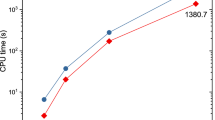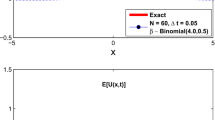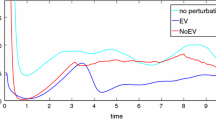Abstract
Second-order exact ensemble averaged equation for linear stochastic differential equations with multiplicative randomness and random forcing is obtained by using the cumulant expansion ensemble averaging method and by taking the time dependent sure part of the multiplicative operator into account. It is shown that the satisfaction of the commutativity and the reversibility requirements proposed earlier for linear stochastic differential equations without forcing are necessary for the linear stochastic differential equations with forcing when the cumulant expansion ensemble averaging method is used. It is shown that the applicability of the operator equality, which is used for the separation of operators in the literature, is also subjected to the satisfaction of the commutativity and the reversibility requirements. The van Kampen’s lemma, which is proposed for the analysis of nonlinear stochastic differential equations, is modified in order to make the probability density function obtained through the lemma depend on the forcing terms too. The second-order exact ensemble averaged equation for linear stochastic differential equations with multiplicative randomness and random forcing is also obtained by using the modified van Kampen’s lemma in order to validate the correctness of the modified lemma. Second-order exact ensemble averaged equation for one dimensional convection diffusion equation with reaction and source is obtained by using the cumulant expansion ensemble averaging method. It is shown that the van Kampen’s lemma can yield the cumulant expansion ensemble averaging result for linear stochastic differential equations when the lemma is applied to the interaction representation of the governing differential equation. It is found that the ensemble averaged equations given for one the dimensional convection diffusion equation with reaction and source in the literature obtained by applying the lemma to the original differential equation are restricted with small sure part of multiplicative operator. Second-order exact differential equations for the evolution of the probability density function for the one dimensional convection diffusion equation with reaction and source and one dimensional nonlinear overland flow equation with source are obtained by using the modified van Kampen’s lemma. The equation for the evolution of the probability density function for one dimensional nonlinear overland flow equation with source given in the literature is found to be not second-order exact. It is found that the differential equations for the evolution of the probability density functions for various hydrological processes given in the literature are not second-order exact. The significance of the new terms found due to the second-order exact ensemble averaging performed on the one dimensional convection diffusion equation with reaction and source and during the application of the van Kampen’s lemma to the one dimensional nonlinear overland flow equation with source is investigated.









Similar content being viewed by others
References
Bellin A, Rubin Y (1996) HYDRO_GEN: a spatially distributed random field generator for correlated properties. Stoch Hydrol Hydraul 10:253–278
Burr DT, Sudicky EA, Naff RL (1994) Nonreactive and reactive solute transport in three-dimensional heterogeneous porous media: mean displacement, plume spreading, and uncertainty. Water Resour Res 30(3):791–815
Cayar M, Kavvas ML (2009) Ensemble average and ensemble variance behavior of unsteady, one-dimensional groundwater flow in unconfined, heterogeneous aquifers: an exact second order model. Stoch Env Res Risk Assess 23:947–956
Dogrul EC, Kavvas ML, Chen ZQ (1998) Prediction of subsurface stormflow in heterogeneous sloping aquifers. J Hydrol Eng 3(4):258–267
Feynman RP (1951) An operator calculus having applications in quantum electrodynamics. Phys Rev 84(1):108–128
Karakas A, Kavvas ML (2000) Conservation equations for ground-water velocities in general conditions. J Hydrol Eng 5(2):206–216
Kavvas ML (2001) General conservation equation for solute transport in heterogeneous porous media. J Hydrol Eng 6(4):341–350
Kavvas ML (2003) Nonlinear hydrologic processes: conservation equations for determining their means and probability distributions. J Hydrol Eng 8(2):44–53
Kavvas ML, Karakas A (1996) On the stochastic theory of solute transport by unsteady and steady groundwater flow in heterogeneous aquifers. J Hydrol 179:321–351
Kavvas ML, Chen Z-Q, Govindaraju RS, Rolston DE, Koos T, Karakas A, Or D, Jones S, Biggar J (1996) Probability distribution of solute travel time for convective transport in field-scale soils under unsteady and nonuniform flows. Water Resour Res 32(4):875–889
Kim S, Kavvas ML, Yoon J (2005a) Upscaling of vertical unsaturated flow model under infiltration condition. J Hydrol Eng 10(2):151–159
Kim S, Kavvas ML, Chen ZQ (2005b) Root water uptake model at heterogeneous soil fields. J Hydrol Eng 10(2):160–167
Kim S, Han S, Kavvas ML (2008) Analytical derivation of steady-state soil water probability density function coupled with simple stochastic point rainfall model. J Hydrol Eng 13(11):1069–1077
Liang L, Kavvas ML (2008) Modeling of solute transport and macrodispersion by unsteady stream flow under uncertain conditions. J Hydrol Eng 13(6):510–520
Ohara N, Kavvas ML, Chen ZQ (2008) Stochastic upscaling for snow accumulation and melt processes with pdf approach. J Hydrol Eng 13(12):1103–1118
Roerdink JBTM (1981) Inhomogeneous linear random differential equations with mutual correlations between multiplicative, additive and initial-value terms. Physica 109A:23–57
Roerdink JBTM (1982) A cumulant expansion for the time correlation functions of solutions to linear stochastic differential equations. Physica 112A:557–587
Roerdink JBTM (1984) Some additional remarks on the cumulant expansion for linear stochastic differential equations. Physica 123A:369–385
Sharma S, Kavvas ML (2005) Modeling noncohesive suspended sediment transport in stream channels using an ensemble-averaged conservation equation. J Hydrol Eng 131(5):380–389
Sirin H (2006) Ground water contaminant transport by nondivergence-free unsteady, and nonstationary velocity fields. J Hydrol 330:564–572
Sirin H, Marino MA (2008) On the cumulant expansion up scaling of ground water contaminant transport equation with nonequilibrium sorption. Stoch Env Res Risk Assess 22:551–565
Soong TT (1973) Random differential equations in science and engineering. Academic Press, New York 327
Tayfur G, Kavvas ML, Govindaraju RS, Storm DE (1991) Applicability of ST. Venant equations for two-dimensional overland flows over rough infiltrating surfaces. J Hydrol Eng 119(1):51–63
van Kampen NG (1976) Stochastic differential equations. Phys Rep 3:171–228
van Kampen NG (1981) Stochastic processes in physics and chemistry. Elsevier Science Publishing Company Inc, New York
Wood BD, Kavvas ML (1999a) Ensemble-averaged equations for reactive transport in porous media under unsteady flow conditions. Water Resour Res 35(7):2053–2068
Wood BD, Kavvas ML (1999b) Stochastic solute transport under unsteady flow conditions: comparison of theory, Monte Carlo, and field data. Water Resour Res 35(7):2069–2084
Yoon J, Kavvas ML (2003) Probabilistic solution to stochastic overland flow equation. J Hydrol Eng 8(2):54–63
Author information
Authors and Affiliations
Corresponding author
Appendices
Appendix 1
Using the following identity given by van Kampen (1981) for any random matrix B and any random vector b as
Eq. 9 can be written in terms of cumulants after partial ordering as
The symbol “\( \langle \langle \quad \rangle \rangle \)” in Eqs. 64 and 65 stands for the cumulant averaging. When Eq. 65 is differentiated with respect to time and a partial truncation is applied based on the assumption that the Kubo number, ατ c , and α smaller than unity the resultant equation is
Please notice that the error made due to the truncation applied to reach Eq. 66 is smaller than α 2 τ c . By using Eq. 65, Eq. 66 can also be written as
When the terms with order smaller than α 2 τ c are omitted Eq. 67 becomes Eq. 10
Appendix 2
The \( D_{c}^{\dag } \) and \( D_{e}^{\dag } \) in Eq. 52 are
in which \( \varsigma = \int\nolimits_{t - s}^{t} {d\eta \langle w(x,\eta ) \rangle } \)
Appendix 3
In order to replace \( \langle c(x + \varsigma ,t - s) \rangle \) with 〈c(x, t)〉 in Eq. 53 and obtain a differential equation for 〈c(x, t)〉 we can write the equivalence of \( \langle c(x + \varsigma ,t - s) \rangle \) by using Taylor series expansion with highest order terms as
Under the assumption that the correlation length among the random operators/variables are τ c Eq. 70 can become as much as
By using Eq. 11 with the first order terms only we can write
The second and the third term in the bracket in Eq. 72 can be omitted by assuming that the Kubo number is smaller than unity as assumed during the cumulant expansion ensemble averaging. In order to omit the first term in the bracket based on the Kubo number restriction again we should require that the order of A 0(t) should be order of α or less so Eq. 72 becomes
Since we already assumed that the order of A 0(t) is α or less we can drop the second term at the right hand side of Eq. 73 so that \( \langle c(x + \varsigma ,t - s) \rangle \) can be replaced with 〈c(x, t)〉 and the terms due to the sure part of the multiplicative operator in Eq. 53 should also be omitted since A 0(t) is assumed to be α or less to obtain
in which \( \xi = \int\nolimits_{t - s}^{\tau } {d\eta \langle w(x,\eta ) \rangle } \quad \varsigma = \int\limits_{t - s}^{t} {d\eta \langle w(x,\eta ) \rangle } \)
We can also replace ς with −ς in Eq. 74 under A 0(t) ≪ α or spatially stationary randomness assumption to reach Eq. 54.
Rights and permissions
About this article
Cite this article
Sirin, H. On the using cumulant expansion method and van Kampen’s lemma for stochastic differential equations with forcing. Stoch Environ Res Risk Assess 27, 91–110 (2013). https://doi.org/10.1007/s00477-012-0591-z
Published:
Issue Date:
DOI: https://doi.org/10.1007/s00477-012-0591-z




